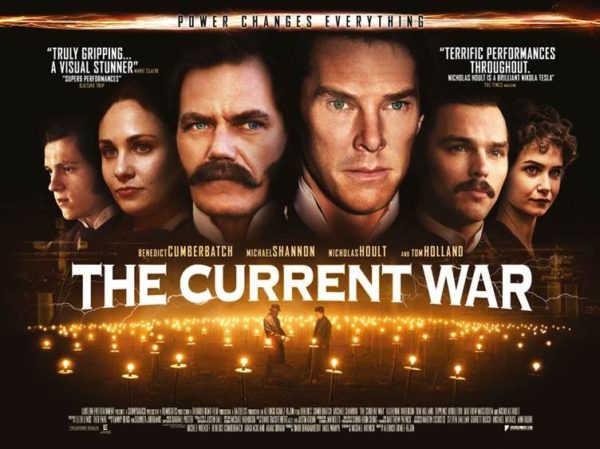LAKSHMI IYER
India Post News Service
On October 25, a film based on the epic rivalry among the greatest minds of the 19th and 20th century was released in the US. It is called “The Current War: Director’s Cut”. As the title reveals, it is about the competition between Thomas Alva Edison (played by Benedict Cumberbatch), scientist and inventor of the electric bulb and many other tools and machines, and George Westinghouse (Michael Shannon), one of the great industrialists of the era. Westinghouse took on another great inventor-scientist, Nikola Tesla (Nicholas Hoult), under his wing. We owe modern hydroelectricity to the visionary Tesla who left behind papers for many other discoveries and inventions, some that only came to fruition much beyond his lifetime.
This correspondent had the opportunity to watch the film.
The story begins in the 1880s when Edison is already a celebrated inventor. He visits the White House with his wife, Mary (Tuppence Middleton), and two children – a son and a daughter – and his secretary, Samuel Insull (Tom Holland), for a private meeting with the President of the United States himself. The famous financier, J. P. Morgan (Matthew Macfadyen), also happens to be there. Edison has a plan to electrify the entire country with his DC (direct current) network, and shows the promise of a huge profit running into millions of dollars (even in that period of time) to Morgan.
In the meantime, George Westinghouse has drawn up an ambitious plan of electrifying the country – with the help of AC (alternating current). Unlike DC that requires huge generators every few miles and subterranean electric wires everywhere, AC needs fewer generators and can do with wires across a network of electric poles. This saves a lot of money. Many city authorities opt to draw up contracts with Westinghouse Electric Company rather than Edison Electric because of the huge cost efficiency difference.
A young Serbian immigrant named Nikola Tesla seeks employment at Edison Electric and Thomas Edison offers him a post with a chance of earning more for coming up with revolutionary ideas.
Tesla tells Edison that he should go with alternating current, too, to minimize costs and gain more customers. The latter, however, is dismissive of his suggestion.
As Edison does not give him a raise in pay nor a chance to pursue his own ideas, Tesla leaves and starts up his own business, only to lose it to a bigger company, Union Electric.
Meanwhile, personal problems start creeping into Edison’s life. His beloved wife, Mary, develops a disease of the brain and passes away, leaving him and the children grief-stricken.
On the professional front, he is adamant about sticking to DC, saying that AC carrying much higher voltages, can be deadly. Journalists and the financier, J. P. Morgan, are skeptical as no deaths had been reported.
An officer of the state approaches Edison to design an apparatus for humane capital punishment. However, the scientist declines to do any such thing as he is against inventing anything that can take a human life.
Paradoxically, in order to prove the deadliness of alternating current, he orchestrates an elaborate demonstration in which a horse is put to death using the technology, thus demonstrating that AC can kill fast. Indirectly, he contributes to the opinion that Westinghouse’s AC current is the most humane way for capital punishment.
On the other side, tragedy strikes when Westinghouse’s trusted employee and associate, Franklin Pope (Stanley Townsend), dies of accidental electric shock.
The events set in motion the development of the electric chair for capital punishment – a method that is still used. Prodded by the state official to help humanize the capital punishment procedure, Edison secretly corresponds with the former. However, he himself is not sure about the exact voltage needed to kill with the least amount of pain, in the shortest possible time. This leads to disastrous results.
Westinghouse hires Nikola Tesla, a recluse living in a hotel room in New York who has all these visionary ideas, including that of generating electric power using the humongous force of Niagara Falls.
The collaboration between the two great men would go down in history as a highly successful one.
The film brings out the human side of the geniuses, particularly Edison. Benedict Cumberbatch delivers a nuanced portrayal of the great man, stubborn and brilliant, driven and consumed by his work, a loving yet at times absent father and husband, who is submerged in grief at his wife’s death. There are particularly touching scenes of him trying to hold on to the memory of his wife through the phonograph recordings of her voice.
The screenplay by Michael Mitnick is brilliant. Michael Shannon’s character, George Westinghouse, has some of the best lines that he delivers with perfect tone. For example, he says in one scene, “It is not my electricity. It’s electricity.”
The supporting cast with Tom Holland as Samuel Insull, Tuppence Middleton as Mary Edison, and Katherine Waterston as Marguerite Westinghouse, is very solid. Nicholas Hoult portrays Nikola Tesla well, complete with the Eastern European accent and youthful ambition. However, his character is mostly relegated to the sidelines, which is unfortunate as he was a genius in his own right, whose brilliance was unknown to many.
Director Alfonso Gomez-Rejon has woven together complex characters quite well. The film is definitely worth one’s time, something that will inspire and educate and give enough food for thought after the last of the credits have rolled.







